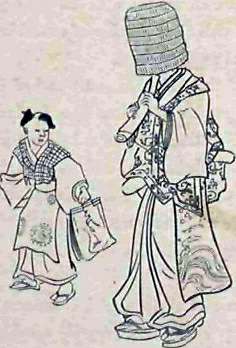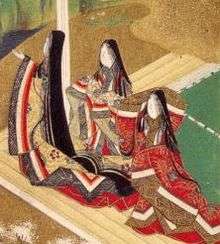Kasa (hat)
A kasa (笠) is any one of several sorts of traditional Japanese hats.[1] Some types are amigasa, jingasa, sandogasa, sugegasa, and takuhatsugasa. Note that rendaku ("sequential voicing") causes kasa to change to gasa when it is preceded by another word specifying the type of hat: thus, jingasa ("camp hat"; helmet).
An amigasa is a straw hat of the type traditionally worn in some Japanese folk dances. Another kind of kasa, the woven rice-straw takuhatsugasa worn by mendicant Buddhist monks, is made overlarge and in a bowl or mushroom shape. Unlike a rice farmer's hat, it does not come to a point, nor does it ride high on the head like a samurai's traveling hat. It is simply a big hat that covers the upper half to two thirds of the face, thereby helping to mask the identity of the monk and allowing him to travel undistracted by sights around him on his journey.
The samurai class in feudal Japan, as well as their retainers and footsoldiers (ashigaru), used several types of jingasa made from iron, copper, wood, paper, bamboo, or leather.[2][3]
Kasa shares its etymology with the Japanese word for "umbrella" (which is also pronounced "kasa", but written 傘). Also known as "San Pan"
Types
Here is a list of several types of kasa:
- Ajirogasa
- Amigasa
- Fukaamigasa
- Jingasa ("war hat", a type of kasa commonly
worn by samurai and ashigaru) - Roningasa
- Sandogasa
- Sugegasa (see Asian conical hat)
- Takuhatsugasa
- Tengai (see Komusō Monk)
- Torioigasa
- Yagyūgasa
See also
- Yatarō gasa (弥太郎笠), Yataro’s Travel Hat - 1957 film by Kazuo Mori.
- Asian conical hat
Gallery
 A Buddhist monk wearing a takuhatsugasa.
A Buddhist monk wearing a takuhatsugasa.
 These women at the Awa Dance Festival wear the characteristic kasa of the dance.
These women at the Awa Dance Festival wear the characteristic kasa of the dance.- Various jingasa from the Return of the Samurai, an exhibit of Samurai art and artifacts held in the Art Gallery of Greater Victoria, Victoria B.C. Canada, August 6 through November 14, 2010.
References
- ↑ Kasa hat Retrieved 03-19-2016
- ↑ Samurai Fighting Arts: The Spirit and the Practice, Author Fumon Tanaka, Publisher Kodansha International, 2003, ISBN 4770028989, 9784770028983 P.46
- ↑ Secrets of the Samurai: The Martial Arts of Feudal Japan, Authors Oscar Ratti, Adele Westbrook, Publisher Tuttle Publishing, 1991, ISBN 0804816840, 9780804816847 P.219
External links
| Wikimedia Commons has media related to Kasa (hat). |
- Haiku Topics (01) ..... (WKD - TOPICS): Hat (kasa) at Haiku Topics (in English)
